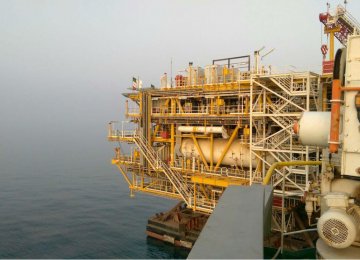Iran needs over $40 billion in investment to prevent natural gas pressure from dipping in the giant South Pars Gas Field in the Persian Gulf by 2023, Oil Minister Bijan Namdar Zanganeh announced on Sunday.
“Pressure reduction will anyway take place [in the South Pars]. However, Iran aims to acquire the knowhow to boost pressure from companies, such as Total,” Shana quoted Zanganeh as saying. The minister added that the French oil and gas company plans to install gas pressure booster facilities, compressors and 20,000-ton platforms in the South Pars Phase 11.
“To do so in all phases, each one needs an investment of more than $1 billion,” he said.
Signed last July, the $4.8-billion gas deal with Total to develop Phase 11 marked the return of the first topflight western oil company to Iran after the easing of international economic restrictions in 2016. Iranian officials say that as soon as Total, as the main contractor, concludes official formalities, subcontracts for the gas projects will be finalized, most of which will be awarded to Iranian firms. Asked whether Iran’s plan to raise oil output conflicts with the country’s commitment to OPEC's oil cut deal, the minister said the Organization of Petroleum Exporting Countries has sealed a deal to cut oil production until the end of 2018, but Iran plans to boost production in the long run.
Prospective Output
Zanganeh believes that oil producers who build capacity for raising output are winners of the oil market, noting that the return on investment in this regard would be very high.
Referring to an OPEC report on oil supply and demand presented about two months ago during the organization’s meeting, the top oil official said according to the report, global crude demand will reach 110 million barrels per day by 2040, which implies that OPEC members can keep selling oil, gas and coal with a small change for the next decades.
He pointed out that Iran’s daily gas consumption has recently hit the equivalent of five million barrels of oil, while about 1.6 million liters of liquefied fuel are also being burnt daily. Zanganeh said the rise in fossil fuel consumption is not desirable in general, but it favors Iran as a big supplier of such fuels.
Curbing Gas Flare
Zanganeh referred to the Oil Ministry's moves to curtail gas flaring at Iran's hydrocarbon processing plants and said new ventures will not be implemented unless their flaring reduction strategies are determined.
"The amount of natural gas flaring in the country should reach zero within a four-year period," he added.
Pointing to measures to tackle the problem in the southern oil- and gas-rich Khuzestan and Asaluyeh, Zanganeh said several sulfur recovery plants have been built in the region, all of which will be inaugurated in the next fiscal year that starts on March 21.
"Once operational, the facilities will reduce the flaring of natural gas," he added. Such plants convert a huge proportion of hydrogen sulfide of gas flares into elemental sulfur while reducing emissions to insignificant levels.
According to the oil minister, several recycling projects are already in place in Khuzestan's South Pars, Kharg and Bid Boland 2 as well as NGL 3100 and 3200 plants in western Ilam Province. Recently, a tender has also been floated for curbing gas emissions, "based on which, the ministry expressed readiness to give the flared gas at a very low price to bidders", Zanganeh said.
Iran is among the top three gas-flaring countries after Russia and Iraq.
According to a report by Majlis Research Center, around 17 billion cubic meters of gas are burned off in Iran annually.











Add new comment
Read our comment policy before posting your viewpoints